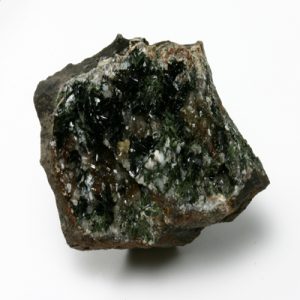Kulanite
Kulanite is a very barium that is a rare mineral that is one of several rare minerals that have recently begun to leave the Yukon Territory. The Formula Of Kulanite is Ba(Fe2+, Mn, Mg)2Al2(PO4)3(OH)3 (Barium Iron Manganese Magnesium Aluminum Phosphate Hydroxide) and its molecular weight is 637.65 gm. Crystals are small so gems usually are very small. Moh’s Hardness is 4.0. Although tiny, gems are appealing with colors ranging from Blue to Green. Crystal habit As plates, to 1.5 cm, tabular on {101}, with {101}, {100}, {001}, {011}, {161}, several others; aggregated in rosettes. Commonly in zoned intergrowth with penikisite.
Kulanite comes from Cross-cut Creek, 1.5 km upstream through the confluence with Rapid Creek, Big Fish-Blow River area, Yukon Territory, Canada. Within the White Picacho district, Maricopa and Yavapai Counties, Arizona, and during the Palermo no. 1 mine, North Groton, Grafton County, New Hampshire, USA. From the Xiyuantou pegmatite, Nanping, Fujian Province, China.
| Chemical Formula: | Ba(Fe2+,Mn,Mg)2Al2(PO4)3(OH)3 | |||||||||||||||||||||||||||||||||||||||||||||
| Barium Iron Manganese Magnesium Aluminum Phosphate Hydroxide | ||||||||||||||||||||||||||||||||||||||||||||||
| Molecular Weight: | 637.65 gm | |||||||||||||||||||||||||||||||||||||||||||||
| Composition: |
|
|||||||||||||||||||||||||||||||||||||||||||||
| Crystallography: | Monoclinic – Prismatic |
| Crystal Habit: | As plates, to 1.5 cm, tabular on {101}, with {101}, {100}, {001}, {011}, {161}, several others; aggregated in rosettes. Commonly in zoned intergrowth with penikisite. |
| Twinning: | None |
| Cleavage: | {010} Good, {100} Good |
| Fracture: | Irregular/Uneven, Conchoidal |
| Tenacity: | Brittle |
| Moh’s Hardness: | 4.0 |
| Density: | 3.91 (g/cm3) |
| Luminescence: | None |
| Radioactivity: | Not Radioactive |
| Other: | S |
| Color: | Blue, Blue-Green, Green, Black-Green |
| Transparency: | Transparent to Translucent |
| Luster: | Adamantine, Vitreous |
| Refractive Index: | 1.703 – 1.723 Biaxial ( + ) |
| Birefringence: | 0.020 |
| Dispersion: | Very Stong and asymmetrical; r > v |
| Pleochroism: | X = brownish green; Y = green; Z = very pale brown. |


